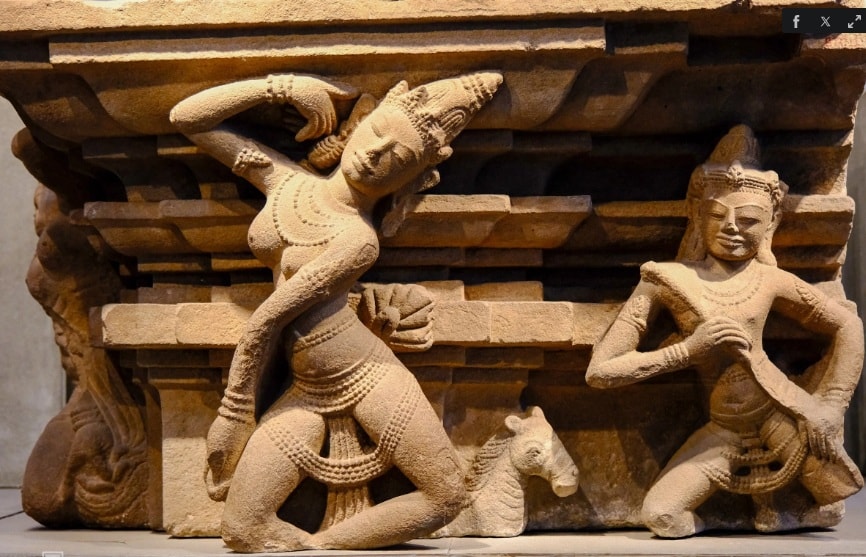
Along both banks, over the centuries, the river has carried heavy alluvium and layers of cultural sediments, layers of traces of ancient civilizations that once existed, leaving behind many mysteries for posterity.
2400 years of evidence
This place still preserves traces of two civilizations, Sa Huynh - Champa, shimmering and mysterious through each layer of sediment.
The archaeological sites that have been excavated and are still lying quietly in the dust of time are all around the ruins of Tra Kieu citadel. The lower Thu Bon river area, where the footprints of the times have converged here, includes many traces of the Sa Huynh people.
The Go Ma Voi site is located on a discolored sand dune 3km southeast of the ruins of Tra Kieu citadel. This site is considered a large burial site of the Sa Huynh culture. Archaeologists have excavated and found the most diverse and abundant number of artifacts compared to other similar sites in the region. Some typical artifacts at this site date back about 2,400 years.
Evidence of this culture was found at the Go Dua site located northwest of the My Son temple complex, a site with a different ecosystem than the Go Ma Voi site. Excavated artifacts at the Go Dua site are currently on display in the museum. Next to the jar tombs are a number of quite rich burial artifacts including jewelry made of precious stones, glass, and agate, which are very sophisticated. Iron tools in the form of a spade with a spread blade are rarely found at other similar sites in the Sa Huynh cultural space.
Where sediments tell stories of thousands of years
The footprints of history do not seem to stop for too long on the mysterious land of the sacred Thu Bon River. From observation, association, and speculation through relics and relics, we can imagine a period of great prosperity following the Sa Huynh period, which was the ancient kingdom of Champa Lam Ap, where important architectural works such as the Tra Kieu citadel and the My Son temple complex were concentrated.
Time has eroded and destroyed much of the unique architectural artistic values of the ancient Cham people, but what remains is associated with the mysterious beauty of the Thu Bon River, which was praised as a sacred river in the ancients' concept.
In the late 1920s, French archaeologist Clay conducted a large-scale excavation of the relics in Tra Kieu Imperial Citadel. Based on the results of the archaeological excavation, Clay outlined the scale of the ancient citadel and proved that Tra Kieu Citadel was the ancient Simhapura Lion Citadel. Among them was the main temple with a height of over 40m. If it remains today, it would be considered the most massive temple in ancient Champa architecture in Southeast Asia.
In this temple tower there is a massive altar, surrounded by reliefs of dancers dancing gracefully before a lotus throne. This altar and countless statues of gods have become masterpieces of ancient sculpture remaining in the world . The wonderful sculptures here show a clear transformation in Champa art, forming a famous artistic style known as Tra Kieu style.
Although it has been in ruins for nearly a millennium, the Simhapura Tra Kieu citadel and what remains underground only show future generations its richness. They both restore and deepen knowledge about an ancient capital that has been in ruins for nearly 1,000 years.
Witness of two successive civilizations
The desolation of the kingdom of Lam Ap Champa was replaced by a new era of Vietnamese immigrants coming here to establish their own businesses, a great migration to the south that in everyday life we rarely have the opportunity to recognize in the busy cycle of crops and plants. The new land, for the ancestors, is now the old land of roots for the descendants. The initial adaptations on the sacred land have become the very unique customs of the people of Quang.
It can be said that, throughout the fields along the southern bank of the Thu Bon River, Quang farmers always live with the mysteries of legends, miracles, and relics densely marked by the footsteps of their predecessors. If we know how to listen, the past will tell us something. The voice can be heard from the precious relics and relics that remain that we can admire in Quang land.
Thu Bon is not only a river, but also an eternal witness of the succession between the Sa Huynh and Champa civilizations. That flow carries within it the prayers of our ancestors, bringing us back to the brilliant and mysterious pages of history. It is also on the banks of that sacred river that the story of a land where two civilizations met and harmonized has been told.
Source: https://baodanang.vn/theo-dau-song-thieng-3302778.html



![[Photo] Vinh Hao-Phan Thiet Expressway has a frog's jaw](https://vphoto.vietnam.vn/thumb/1200x675/vietnam/resource/IMAGE/2025/9/13/a89ffa426f7a46ffb810cb1d7bdfb1b8)


![[Photo] Off-road racing: Adventure sport, attractive tourism product](https://vphoto.vietnam.vn/thumb/1200x675/vietnam/resource/IMAGE/2025/9/14/45123bd29c884b64934da038d947d344)

![[Photo] General Secretary To Lam attends the Digital Popular Education Symposium - Digital National Assembly](https://vphoto.vietnam.vn/thumb/1200x675/vietnam/resource/IMAGE/2025/9/13/43ebd93f0f5e4d98a2749dab86def7cd)
































































































Comment (0)